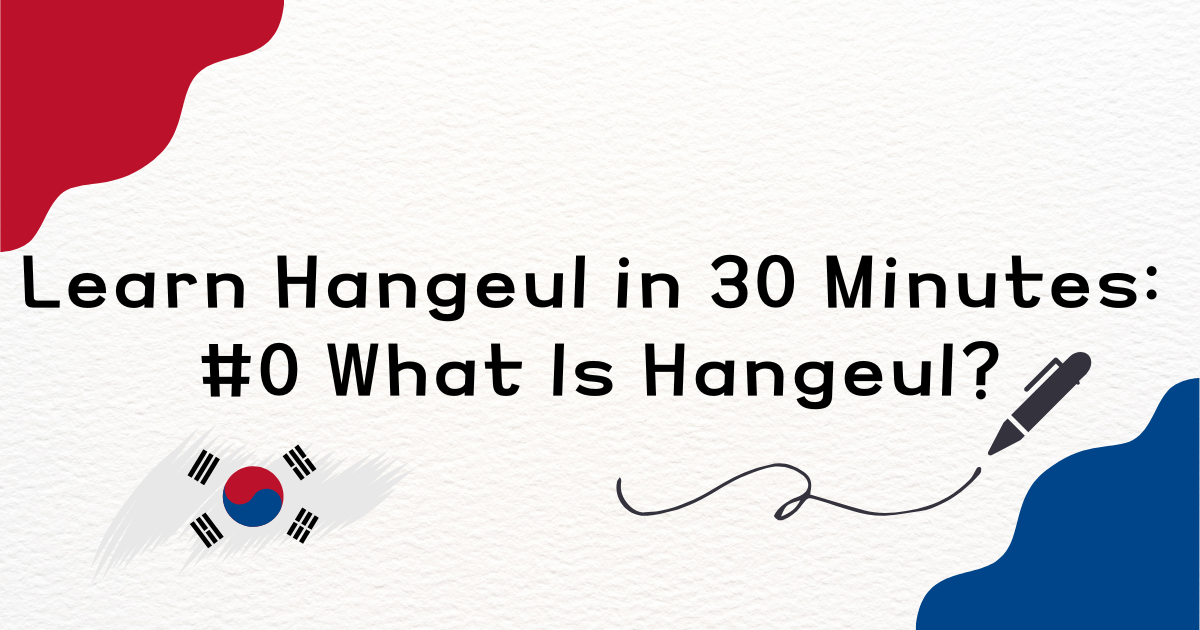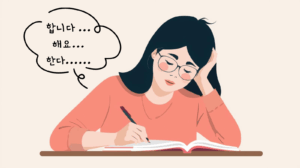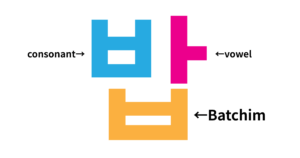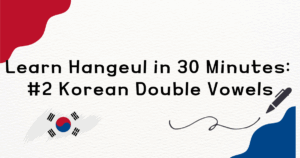💌 Want more K-POP deep dives like this?
Subscribe to Hello Bias Letters, our free Substack newsletter!
Each week, we unpack K-POP culture with care—from fan behavior to behind-the-scenes stories.
→ Join us here
Introduction: Why Starting with the Alphabet Makes Everything Easier
Recently got into BTS? Can’t stop thinking about Squid Game?
Korean pop culture is full of amazing content—and once you’re hooked, you probably find yourself thinking:
“I wish I could understand more Korean!” or
“Korean looks so hard… but I still want to enjoy it more deeply!”
That’s exactly why I decided to create this beginner-friendly Korean series on Substack.
No prior knowledge of Korean? No problem.
We’ll take it step by step, and each week, you’ll build up your Korean skills little by little.
Among the many challenges of learning Korean, the first and biggest hurdle for most beginners is the writing system—Hangeul.
But here’s the good news: Hangeul is one of the most well-designed alphabets in the world.
Once you understand the system, it becomes surprisingly easy to read.
Today, let’s break it down together—so you can start reading Korean letters in just 30 minutes.
Thanks for reading Hello Bias Letters! Subscribe for free to receive new posts and support my work.Subscribed
What Is Hangeul? A Bit of History and Why It’s So Logical

Why is it that Hangeul is easier to read than it looks?
That’s because it wasn’t developed over centuries like many other writing systems—it was intentionally invented by King Sejong the Great in 1443.
(If you ever visit Korea, you can actually see a statue of King Sejong in Gwanghwamun Square—go say hi!)
Back in the day, Koreans used Chinese characters to read and write.
But those characters were so complex that only the elite could learn them—ordinary people had no access to literacy.
King Sejong saw this as a major problem, so he set out to create a writing system that anyone could learn. That’s how Hangeul was born.
The beauty of Hangeul lies in its structure.
It’s a phonetic alphabet—a writing system where each symbol represents a specific sound.
It’s made up of consonants (자음) and vowels (모음), which are combined to form syllables.
For example:
The syllable “가” is made from two building blocks—“ㄱ” (a consonant) and “ㅏ” (a vowel).
Each block looks different, but once you get the hang of the system, it all starts to make sense.
Sure, memorizing the shapes of consonants and vowels might take a little time.
But once you learn the rules, you’ll be able to sound out almost any Korean word, even if you’ve never seen it before.
(And trust me, soon you won’t even need to “sound it out”—you’ll just read it.)
I still remember how frustrated I was when I first got into Korean pop culture.
I couldn’t understand a word of what my favorite idols were saying—and it drove me crazy!
But the more I looked up the letters, practiced reading, and said the sounds out loud, the more things started to click.
Yes, the beginning can feel a bit tough.
But once you get past the basics, a whole new world of Korean culture opens up to you.
3. Understanding the Basic Structure of Hangeul
The basic structure of Hangeul characters is very simple.
There are two main patterns for how Hangeul characters are formed.
Think of it like assembling blocks—let’s learn step by step.
3-1. Pattern 1: Consonant (자음) + Vowel (모음)
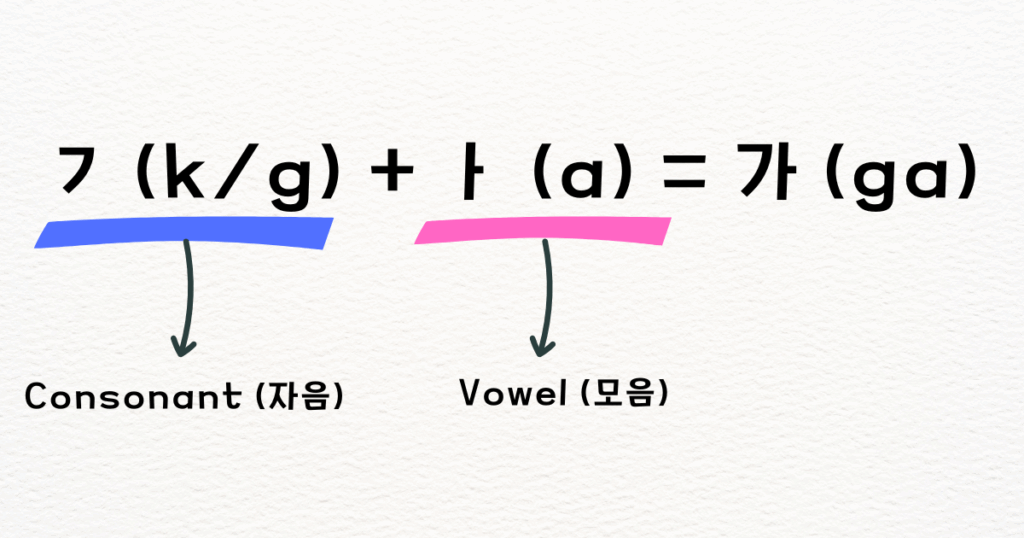
This is the simplest pattern.
You create sounds by combining a consonant and a vowel.
Here are some examples:
- ㄱ (k/g) + ㅏ (a) = 가 (ga)
- ㄴ (n) + ㅏ (a) = 나 (na)
- ㄷ (d/t) + ㅏ (a) = 다 (da)
- ㅁ (m) + ㅏ (a) = 마 (ma)
Key points:
- The consonant always comes on the left side, and the vowel on the right side.
- There is also a pattern where the consonant is on top and the vowel is below.
- This usually happens when the vowel is vertical in shape, like ㅗ, ㅜ, or ㅡ.
Examples:
- ㅂ (b/p) + ㅜ (u) = 부 (bu)
- ㅁ (m) + ㅗ (o) = 모 (mo)
- ㅅ (s) + ㅡ (eu) = 스 (seu)
Summary for this section:
- The consonant is placed on the left or top; the vowel is placed on the right or bottom.
- Whether the vowel goes on the right or below depends on its shape.
3-2. Pattern 2: Consonant (자음) + Vowel (모음) + Batchim (받침)
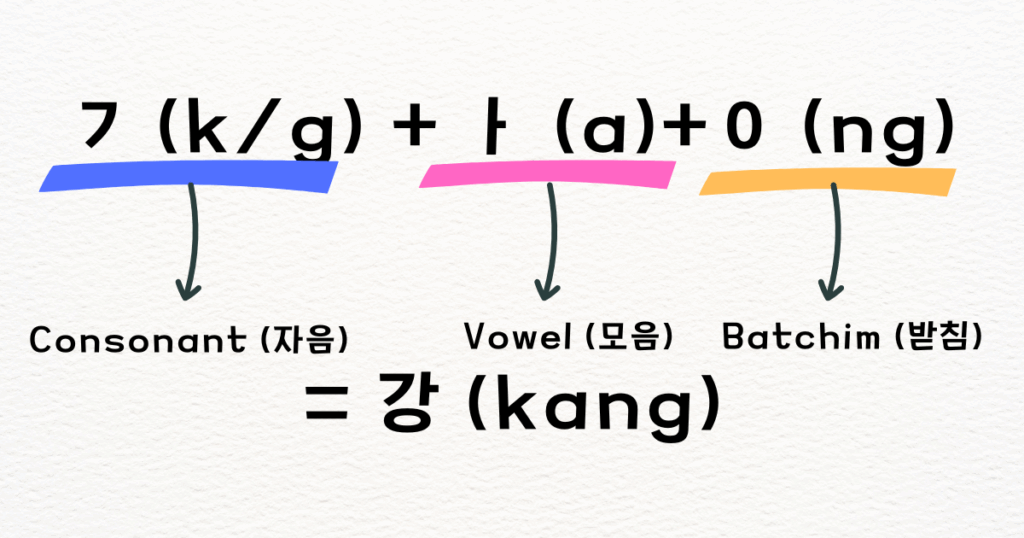
Next, let’s learn the pattern that includes a batchim (받침).
Batchim refers to the consonant placed at the very bottom of the character block—also called the final consonant.
This means the reading order is: consonant + vowel + consonant.
Here are some examples:
- 강 (kang) → ㄱ (k) is the initial consonant, ㅏ (a) is the vowel, ㅇ (ng) is the batchim
- 밥 (bap) → ㅂ (b) is the initial consonant, ㅏ (a) is the vowel, ㅂ (p) is the batchim
- 몸 (mom) → ㅁ (m) is the initial consonant, ㅗ (o) is the vowel, ㅁ (m) is the batchim
Batchim can affect pronunciation and grammar in Korean.
However, if you try to learn too much about it at once, it can get confusing.
For now, just remember that batchim is the final consonant sound in the syllable.
4. Let’s Try Reading Real Korean Words
Now that you’ve learned how to combine consonants and vowels, let’s look at 7 simple Korean words you can read right away.
Go through each one slowly and try sounding them out.
- 나 (na) : ㄴ (n) + ㅏ (a) – I, me
- 너 (neo) : ㄴ (n) + ㅓ (eo) – You
- 우리 (uri) : ㅇ (silent) + ㅜ (u) / ㄹ (r) + ㅣ (i) – We, us
- 아기 (agi) : ㅇ (silent) + ㅏ (a) / ㄱ (g) + ㅣ (i) – Baby
- 아니 (ani) : ㅇ (silent) + ㅏ (a) / ㄴ (n) + ㅣ (i) – No,
- 가요 (gayo) : ㄱ (g) + ㅏ (a) / ㅇ (silent) + ㅛ (yo) – I go / Let’s go (polite form)
- 어디 (eodi) : ㅇ (silent) + ㅓ (eo) / ㄷ (d) + ㅣ (i) – Where?
Wait, where are the consonants in “아” or “우”?
You might be wondering:
Why does 아 sound like a and 우 sound like u? Where’s the consonant?
The answer is: the consonant “ㅇ” is silent when it appears at the beginning of a syllable.
So, when a syllable starts with ㅇ + vowel, only the vowel is pronounced.
Don’t worry about remembering all the rules right now—we’ll come back to this point in a future lesson. For now, just keep it in the back of your mind.
5. What Can You Do Once You Can Read Hangeul?

You might be thinking,
“Is there any point in learning Hangeul if I can’t understand Korean yet?”
Absolutely yes!
Once I started reading and listening to Korean, I was able to enjoy Korean culture so much more.
I could understand the lyrics of K-pop songs—even without looking at the lyric sheet.
I started catching bits of dialogue in dramas.
And when I traveled to Korea, I could communicate (even just a little!) with locals in their language.
Just being able to read Hangeul means you can read menus at restaurants and order what you want—not just point and guess.
It may feel hard at first, but if you love Korean culture, learning Hangeul is definitely worth it.
6. How This Course Works — and What’s Coming Next
Here’s how we’ll move forward with this Hangeul course:
- We’ll learn vowels and consonants step by step, starting from the simplest.
- You’ll be encouraged to actively practice what you learn—not just read.
- The ultimate goal is to connect sound and shape, so you can actually read Korean.
- Each lesson is designed to be completed in under 30 minutes—perfect for busy days.
(Just reading is fine, and you can practice more if you want!)
💬 If you found this post helpful, consider supporting me with a coffee!
Your support keeps Hello Bias going ☕💛
👉 Buy Me a Coffee
